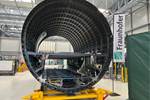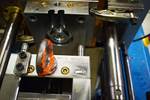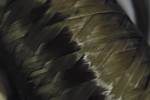Aitiip concludes HELACS project with waterjet cutting demonstration
Novel platform involving digital twin and human-robot collaboration succeeded in cutting a component from the 19th section of an A350 wing, highlighting its ability to enable composite structure recycling.
Share
Read Next
After more than 3 years of research, the Aitiip Technology Center (Zaragoza, Spain) successfully concluded the HELACS project in March. An initiative financed by the European Commission’s Clean Sky 2 program, HELACs aimed to develop a comprehensive dismantling methodology to enable the classification, recycling and reuse of large composite components from aircraft that have arrived at their end of life.
At the beginning of this project, HELACS proposed a dismantling process based on a selective cutting system by high-pressure water (more than 4,000 bars) that would enable pieces composed of a thermoset matrix (carbon fiber/epoxy) to be cut into pieces. In this way, it’s goal was to promote the creation of new recovery methods for different composite aircraft components, to enhance the worldwide dismantling process (read “Aitiip ... reports dismantling of thermoplastic parts using resistance welding”).
Teruel Airport, a partner in the project, hosted the final demonstration of the resulting technology at one of its hangars. The dummy tool, which exploits a digital twin and human-robot collaboration, enables a robotic dismantling platform, patented by Aitiip, to reproduce the movement previously outlined by an operator, so that the robot can then carry out the same route by cutting via pressurized water.
For the test, which was attended by composite materials and aerospace company representatives, as well as members of AERA and AEMAC, the HELACS team succeed in water cutting a composite structure from the 19th section of an A350 wing (watch the demonstration video here). With this development, Aitiip is promoting a technological solution capable of facing the ecological, logistical and technical challenge of more than 680,000 tons of end-of-life composite materials projected for 2025.
Related Content
-
Materials & Processes: Fibers for composites
The structural properties of composite materials are derived primarily from the fiber reinforcement. Fiber types, their manufacture, their uses and the end-market applications in which they find most use are described.
-
Cryo-compressed hydrogen, the best solution for storage and refueling stations?
Cryomotive’s CRYOGAS solution claims the highest storage density, lowest refueling cost and widest operating range without H2 losses while using one-fifth the carbon fiber required in compressed gas tanks.
-
Materials & Processes: Resin matrices for composites
The matrix binds the fiber reinforcement, gives the composite component its shape and determines its surface quality. A composite matrix may be a polymer, ceramic, metal or carbon. Here’s a guide to selection.














